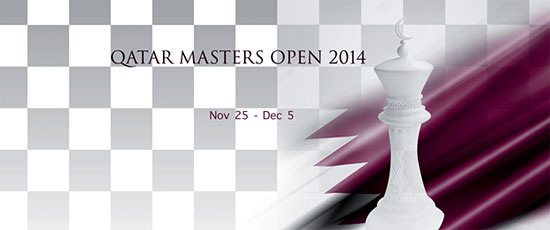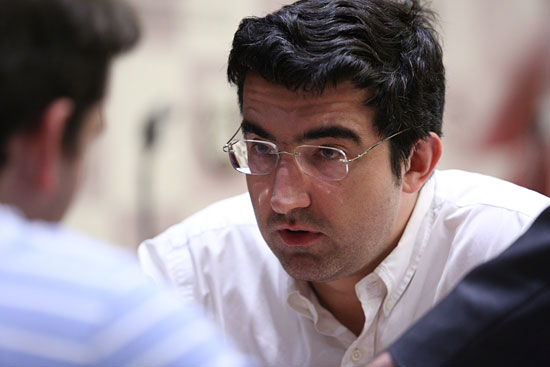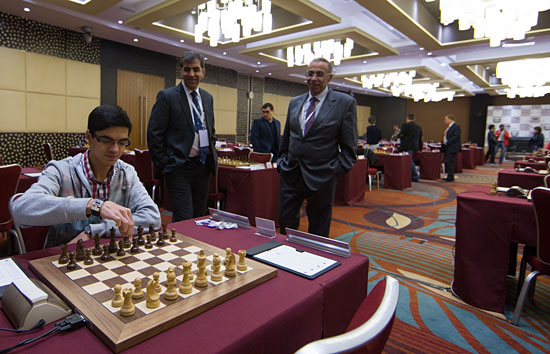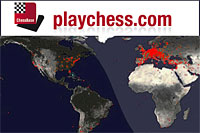
The Qatar Masters Open 2014
is being held from November 25 to December 5 at the Crowne Plaza Hotel in
Doha, Qatar. There are 92 grandmasters participating, or 60% of the 154
total players. 56 GMs are over rated 2600, and an incredible 14 over 2700.
Let those numbers sink in for a moment! This tournament truly is a convention
of brilliant chess minds.
Anish Giri leads Qatar Masters with 6.0/6
Report from Doha by Akshat Chandra
Another day, another round, and another win for the top seed GM Anish Giri,
who has elevated his score to a phenomenal 6.0/6! Today he took down Swedish
GM Nils Grandelius, who was having a breakout tournament as well. It was
a long, thoughtful game, and things were very even for a while before Giri
eventually ground out a win in an endgame. Grandelius defended extremely
well and tenaciously, before eventually cracking under the relentless pressure.
It’s always instructive to see how strong GM’s overcome equally
strong players in a seemingly balanced position.


[Event "Qatar Masters Open"] [Site "Doha"] [Date "2014.12.01"] [Round
"6.1"] [White "Giri, Anish"] [Black "Grandelius, Nils"] [Result "1-0"]
[ECO "A05"] [WhiteElo "2776"] [BlackElo "2573"] [Annotator "Sagar Shah"]
[SetUp "1"] [FEN "1r6/4k3/4p3/P2nN1p1/8/5P2/2R2K2/8 b - - 0 60"] [PlyCount
"28"] [EventDate "2014.??.??"] [WhiteClock "0:04:22"] [BlackClock "0:02:50"]
{Giri was on 5.0/5, having a wonderful tournament. He was demolishing
his opponents in miniature games that lasted less than 20 moves. But today
Grandelius made him work hard for the point, and after 60 moves the games
is quite equal.} 60... Rb5 $6 (60... Ra8 {was a simple way to maintain
equality.}) 61. a6 Nb4 $2 (61... Ra5 {is impossible due to the knight
fork.} 62. Nc6+ $18) (61... Kf6 {was relatively the best.} 62. a7 Ra5
63. Nc6 Ra6 64. Rb2 Nc7 65. Rb7 Rxc6 66. Rxc7 Ra6 $11 {and Black will
be able to hold a draw here.}) 62. a7 Ra5 63. Rb2 {The knight cannot move
because of the fork on c6. By simple means White has won a piece.} Kf6
64. Ng4+ Kf5 65. Ne3+ Kf6 66. Rxb4 Rxa7 {Giri now finishes off this game
in Super grandmaster style!} 67. Rb5 Ra4 68. Kg3 Ra6 69. Ng4+ Kg6 70.
Nf2 Rd6 71. Kg4 (71. Rxg5+ $1) 71... Rd2 72. Rxg5+ Kh6 73. Rh5+ Kg6 74.
Rh2 {It seems as if it is impossible to stop Mr. Anish Giri in Qatar!}
1-0

Swedish GM Nils Grandelius during the daunting
task of playing a Super-GM on a roll

Speaking about "on the roll", here's
another Super-GM about whom that may be said
The second seed and former World Champion Vladimir Kramnik continued his
comeback with a swift 25-move win over his compatriot Sanan Sjugirov. The
game started out as a quiet Reti, before suddenly escalating into a complex
and exciting struggle. Black had to play accurately, and for a time Sjugirov
was managing to do just that. But as usually happens, when under continuous
pressure, one makes a blunder, and this game was no exception. Sjugirov
tried his luck with a dubious piece sacrifice, but Kramnik accurately refuted
it, and won the game shortly after.

[Event "Qatar Masters Open"] [Site "Doha"] [Date "2014.12.01"] [Round
"6.2"] [White "Kramnik, Vladimir"] [Black "Sjugirov, Sanan"] [Result "1-0"]
[ECO "A05"] [WhiteElo "2760"] [BlackElo "2673"] [Annotator "Sagar Shah"]
[PlyCount "49"] [EventDate "2014.??.??"] [WhiteClock "0:26:04"] [BlackClock
"0:08:34"] {Kramnik was on a high after three wins in the three previous
rounds. Today he played the young Russian Sanan Sjugirov. In 2010, Sanan
had beaten Magnus (2826) in Khanty Mansiysk Olympiad 2010. So he could
not be taken lightly.} 1. Nf3 Nf6 2. g3 d5 3. Bg2 c6 4. d3 Bg4 5. O-O
{When I had just started playing chess, my coach advised me to play these
exact five moves from the white side, just so that I wouldn't lose the
game quickly. Kramnik plays this setup just so that he can play an original
game without too much opening theory.} Nbd7 6. Qe1 {Kramnik has good experience
with this line, as he played it with the white pieces against Vitiugov
in the Alekhine Memorial in 2013 and against Levon Aronian with the black
pieces in 2010.} e5 7. e4 {of course the threat is now exd5 followed by
taking on e5.} Bd6 (7... dxe4 {is the main line in this position.} 8.
dxe4 Bd6 9. Nbd2 O-O 10. h3 Bh5 11. Nc4 Bc7 12. a4 Re8 ( 12... b5 13.
axb5 cxb5 14. Ne3 $14 {[%cal Ge3d5]}) 13. Nh4 Nc5 14. Nf5 Ne6 15. Be3
$14 {when White had a very harmonius development and went on to win. 1-0
(50) Kramnik,V (2801)-Vitiugov,N (2712) Paris/St Petersburg 2013}) 8.
h3 Bh5 9. Nh4 {Kramnik is in an agressive and unconventional mood –
as he usually is when not facing a 2750+ opponent! He starts an attack
without developing his queenside minor pieces.} O-O 10. g4 Bg6 11. g5
(11. Nf5 {is not at all good because of} Bxf5 12. exf5 (12. gxf5 Re8 {when
Black has a very solid and nice position.}) 12... h6 {preventing g5 for
the time being.} 13. Qd1 Re8 14. Re1 ( 14. h4 $2 Nh7 $17) 14... Qb6 {Once
again a very harmonius position for Black.}) 11... Nh5 12. exd5 {Kramnik
indulges himself by winning the crucial d5 pawn, burning all bridges in
the process. He has pushed his kingside pawns in such a fashion that weaknesses
abound in the white position. I feel that Black should have enough compensation
for the missing pawn.} cxd5 13. Nxg6 hxg6 14. Bxd5 Nf4 $1 $44 {Sjugirov
starts of well. He attacks the d5 bishop and also the g5-pawn forcing
White to take the knight on f4.} 15. Bxf4 exf4 16. h4 {These kingside
pawns might look weak, but one important fact to understand here is that
Black would like to break this structure with f6 at some point. With the
bishop so strongly placed on d5, however, it is simply impossible.} Qc8
$1 {Openly eyeing the c2 pawn and in a stealthy way also the g4 square!}
17. Qe4 $1 { Kramnik is a class act. You can bank on him finding the most
challenging and ambitious moves in the position. That's the reason why
he played in such daredevil fashion in the opening.} (17. Nc3 Ne5 18.
Qe4 Qg4+ 19. Qg2 Qxh4 { gives Black a lot of counterplay.}) 17... Qxc2
{Sjugirov goes for the most critical continuation, asking White what exactly
is he trying to do.} (17... Re8 18. Bxb7 $5 (18. Qxg6 Ne5 19. Qe4 Ng6
$5 20. Qxg6 Qg4+ 21. Kh1 Qh3+ $11) 18... Qxc2 (18... Rxe4 19. Bxc8 $16)
19. Qc6 Qxc6 (19... Qxb2 20. Bxa8 Qxa1 21. Qxd6 $18) 20. Bxc6 $16) 18.
Nc3 {This is the most logical way to develop. The knight comes into the
center.} (18. Na3 {might have been interesting.} Bxa3 ( 18... Qxb2 19.
Nc4 $18) 19. bxa3 Rad8 (19... Rae8 20. Bxf7+ Kxf7 21. Qd5+ $16 Ke7 22.
Rac1 Qa4 23. Rc4 Qa6 24. Rb1 $18 {with a fierce attack.}) 20. Qxf4 Nc5
{and in spite of being a pawn down, it is clear that Black is not much
worse because the white position has so many weaknesses.}) (18. Qxg6 {[%cal
Gg6d6]} Bc5 (18... Qxb2 19. Qxd6 Qxa1 20. Qxd7 $18) 19. Qh5 {threatening
g6.} Qxd3 20. g6 Qg3+ $1 21. Kh1 Qh3+ {would be a nice way to end the
game.}) 18... Qxb2 19. Qxg6 Bc5 (19... Qxc3 20. Qxd6 Ne5 (20... Rad8 {It
is extremely difficult to assess positions like these. But say after}
21. Rac1 Qe5 22. Qxe5 Nxe5 23. Bxb7 Rxd3 $11 {/+=. The number of pawns
on the board are equal and Black should be able to hold this one.}) 21.
Rac1 Qd4 $5 22. Rc4 $1 (22. Bxf7+ Rxf7 23. Qxd4 Nf3+ $19) 22... Qb2 (22...
Nxc4 23. Bxf7+ $18) 23. Re4 (23. Rxf4 Rad8 $19) 23... Nf3+ 24. Kg2 Nxh4+
25. Kh3 Nf3 26. g6 Ng5+ 27. Kh4 Nxe4 28. dxe4 $14 { [%csl Gh4] The king
on h4 looks quite safe, and in this position White stands better. A completely
non-forcing and long variation to show you how tricky and complicated
the position is.}) 20. Ne4 Qe5 {Now after Bb3 White has a lot of threats
in the position, but the question is instead of Qe5 what should have Black
played? His position looks already quite perilious.} (20... Qd4 21. Bb3
Qxd3 22. Nf6+ $18) (20... Rad8 21. Rab1 Qd4 22. Bb3 Be7) (20... Ne5 21.
Nf6+ Kh8 22. Qh7#) (20... Rae8 21. Rae1 $18 {[%csl Gd5,Ge1,Ge4,Gg6]})
21. Bb3 $1 $14 {The white rook is coming to e1 now. What should Black
do?} Bxf2+ (21... f3 22. Rae1 $1 Qf4 23. Qh5 $18 {With the threat of g6.})
(21... Be7 22. Rae1 {Seems safer but you can clearly see who holds the
initiative.}) 22. Nxf2 $1 { accurately calculated.} (22. Kxf2 {was a possibility.}
Qb2+ 23. Kg1 Qxb3 24. Qxg7+ Kxg7 25. axb3 f6 26. Rxf4 fxg5 27. Rg4 $14
{It will be touch and go question whether White can win this or not.})
22... f3 23. Ne4 {stopping the check on g3.} Qd4+ {Playing for the last
trick. But the way Kramnik has been conducting this entire game, it is
hard to imagine that he will stumble now.} ( 23... Qb2 24. Rxf3 $1 (24.
Nf6+ Nxf6 25. gxf6 Qd4+ 26. Kh2 Qxh4+ 27. Kg1 Qd4+ $11 {would have been
a nice draw for Black.}) 24... Qxb3 (24... Qxa1+ 25. Rf1 Qd4+ 26. Rf2
$18 {The threat of Nf6 is a killer and Black can do nothing about it.})
25. Qxg7+ Kxg7 26. axb3 {This endgame is pretty bad, but maybe it was
Black's last chance to continue the game.}) 24. Kh1 $1 (24. Kh2 $2 Qb2+
25. Nf2 (25. Rf2 Qxa1 $13) 25... Qxb3 26. Qxg7+ Kxg7 27. axb3 Nc5 {Black
is ok.}) 24... Qb2 25. Nf6+ $1 {The final check well calculated by Kramnik.}
({After} 25. Nf6+ Nxf6 26. gxf6 {[%csl Rg2][%cal Rg6g7,Gg6g2] the queen
not only threatens a mate on g7 but also controls the mating square g2.})
1-0

A fantastic game by Kramnik. One cannot really pinpoint where Sjugirov
(above before the start of the game) went wrong. Maybe the entire idea with
7...Bd6 is dangerous for Black and he should stick to the simple 7...dxe4.
But in order to refute Black's play you need a player like Kramnik who feels
the position like a human and calculates like a machine!

Will he manage to do a Caruana*? Anish before
the start of a game with black
* caruana
Syllabification: ca·ru·a·na, Noun
The act of preposterously winning the first seven games in a very strong
chess tournament. Origin: from the Italian, coined after GM
Fabiano Caruana's feat of scoring seven straight wins in the first
seven rounds of the strongest tournament of all times.
Usage: to do a caruana, pull off a caruana, narrowly miss a caruana |
These unequivocal results today, set up a showdown between Giri and Kramnik,
who will meet in what will be a closely watched and exciting clash between
two of the world greats. What more could we have asked for? This matchup
is reminiscent of the Anand-Carlsen World Championship match, which featured
two world class players separated by a generation. Kramnik will have the
white pieces, which gives him a slight edge. But Giri has been invincible
so far. It’s a good example of when an immovable object, Kramnik,
meets an unstoppable force, Giri. Feel free to leave your thoughts about
this pivotal matchup, which starts at three p.m. Doha time, in the comment
section below!
Other highlights from rounds six, annotated by IM Sagar Shah

[Event "Qatar Masters Open"] [Site "Doha"] [Date "2014.12.01"] [Round
"6.6"] [White "Ivanisevic, Ivan"] [Black "Mamedyarov, Shakhriyar"] [Result
"1-0"] [ECO "A85"] [WhiteElo "2643"] [BlackElo "2757"] [Annotator "Sagar
Shah"] [SetUp "1"] [FEN "8/pp6/3k2p1/2p2p2/2P1bP2/2P3K1/P5P1/5B2 w - -
0 33"] [PlyCount "23"] [EventDate "2014.??.??"] [WhiteClock "0:27:07"]
[BlackClock "0:36:26"] {Black has a fine bishop endgame. Equal pawns with
a good structure. It is true that he is not better, but he is nowhere
close to losing. It's interesting to see how Mamedyarov, who is such a
strong player, lost this endgame.} 33. Kh4 Bb1 34. a3 Kc6 $2 {Where exactly
is the king going? Mamedyarov loses his objectivity and plays for a win
in a drawn position.} ( 34... Ke6 35. Kg5 Kf7 $11 {was of course an easy
draw.}) 35. Kg5 Kb6 36. Kxg6 Ka5 37. g3 $1 {Preparing Bh3 to attack the
pawn on f5.} Ka4 38. Bh3 Bd3 $2 { This loses trivially.} (38... a5 39.
Bxf5 Bxf5+ 40. Kxf5 Kxa3 41. Kg6 a4 42. f5 Kb3 43. f6 a3 44. f7 a2 45.
f8=Q a1=Q 46. Qxc5 Qxc3 47. g4 {This endgame is unpleasant for Black,
but there are definitely a lot of drawing chances.} Qd3+ (47... Qxc4 $2
48. Qxc4+ Kxc4 49. g5 b5 50. Kf5 b4 51. g6 b3 52. g7 b2 53. g8=Q+ $18)
48. Kh6 Qh3+ 49. Qh5 $16) 39. Bxf5 Bxc4 40. Bd7+ $1 Kxa3 41. f5 b5 ( 41...
a5 42. Be6 $1 Bd3 43. Kg5 a4 44. f6 Kb2 45. f7 $18) 42. f6 b4 43. cxb4
Kxb4 44. g4 {Mamedyarov realized that he had blown the endgame and resigned.}
( 44. g4 a5 45. g5 a4 46. Bxa4 Kxa4 47. Kg7 (47. f7 $2 Bxf7+ 48. Kxf7
c4 $11) 47... Be6 48. g6 c4 49. f7 Bxf7 50. gxf7 c3 51. f8=Q c2 52. Qf4+
$1 Kb3 53. Qc1 $18 {In chess it doesn't matter who you are. If you lose
your sense of objectivity, you are bound to be punished.}) 1-0

[Event "Qatar Masters Open"] [Site "Doha"] [Date "2014.12.01"] [Round
"6.16"] [White "Swiercz, Dariusz"] [Black "Mamedov, Rauf"] [Result "0-1"]
[ECO "D11"] [WhiteElo "2616"] [BlackElo "2652"] [Annotator "Sagar Shah"]
[SetUp "1"] [FEN "8/5pk1/3R2p1/8/p7/4P3/r5PP/6K1 w - - 0 32"] [PlyCount
"36"] [EventDate "2014.??.??"] [WhiteClock "0:13:44"] [BlackClock "1:13:37"]
{Black has the tiniest bit of advantage thanks to his outside passer.
But this particular position should be an easy draw for White. How did
a 2600+ player manage to lose it? Let's have a look.} 32. Ra6 {Keeping
the rook behind the passed pawn= good idea!} g5 33. h3 f5 34. Kh2 Ra3
35. h4 $6 {There was no need to go for these complications.} (35. Kg1
$11 {was safe}) (35. g4 $11 {was also pretty good.}) 35... gxh4 36. Kh3
(36. g3 {was an easy way to draw.} Rxe3 ( 36... hxg3+ 37. Kxg3 Rxe3+ 38.
Kf4 $11) 37. gxh4 a3 38. Kg2 $11 {should also not be much for Black.})
36... f4 37. Kxh4 fxe3 38. Kg3 $2 {This is now the critical error. Being
the 38th move it is quite possible that Swiercz was in grave time trouble.}
(38. Re6 Kf7 39. Re4 Kf6 40. Kg4 Rc3 41. Kf3 a3 42. Ra4 $11 {and with
precise play, White has things under control.}) 38... e2+ 39. Kf2 Re3
$1 40. Ke1 a3 {Now it is completely losing, as White is in zugzwang. He
cannot move the g-pawn as we shall see, or his king, and if he moves the
rook it helps the black king to enter the game.} 41. Rd6 (41. g4 Rh3 $1
42. Kxe2 a2 $1 43. Kd2 Rh1 $1 $19 {a very typical endgame trap!}) (41.
g3 Kf7 {once again putting White in a zugzwang.}) 41... Kf7 42. Rd5 (42.
Ra6 Ke7 43. Rb6 Kd7 { slowly the black king makes his way to the queenside
and then up the board. The sad part, as we have seen previously, is that
White cannot even push his g-pawn, as it loses tactically.} 44. Ra6 Kc7
45. Rf6 Kb7 46. Rf5 Kb6 $19) 42... Ke6 43. Rd4 Ke5 44. Rd8 Ke4 45. Rd7
Rb3 46. Re7+ (46. Kxe2 Rb2+ 47. Ke1 a2 $19) 46... Kd3 47. Rd7+ Kc3 48.
Ra7 Kb2 49. Kxe2 a2 {Time trouble is a big monster in chess. It makes
great players like Swiercz commit unthinkable mistakes!} 0-1

[Event "Qatar Masters Open"] [Site "Doha"] [Date "2014.12.01"] [Round
"6.18"] [White "Jobava, Baadur"] [Black "Hovhannisyan, Robert"] [Result
"1-0"] [ECO "C54"] [WhiteElo "2722"] [BlackElo "2591"] [Annotator "Sagar
Shah"] [SetUp "1"] [FEN "r3rnk1/bp1b1pp1/2pp1q1p/P3p3/1P2P3/1B1PNNP1/4QPKP/R1R5
w - - 0 21"] [PlyCount "29"] [EventDate "2014.??.??"] [WhiteClock "0:44:30"]
[BlackClock "0:06:02"] {Jobava is a magician on the chessboard. If you
have missed it, do check his fifth round win in which he jogs his black
king down to f2 to checkmate the opponent. Today's game is no less pretty.}
21. b5 $1 Bc5 {the human move.} ( 21... cxb5 {was relatively better.}
22. Nd5 Qe6 $1 {it is not so easy to place your queen under a discovered
attack.} (22... Qd8 23. Nc7 $16) 23. Nc7 (23. Rab1 Qh3+ $1 24. Kg1 Bg4
$36) 23... Qxb3 24. Rcb1 Qc3 25. Rc1 $11 {with an equal game.}) 22. a6
$1 bxa6 $2 (22... Ra7 {maintaining the position was better.} 23. axb7
Rxb7 24. bxc6 Rxb3 25. cxd7 Nxd7 $14) 23. bxc6 $1 { deflecting the bishop
from the key diagonal.} Bxc6 (23... Be6 {was the lesser evil, but would
have given White a good position anyway after} 24. Bxe6 Nxe6 ( 24... fxe6
25. Rxc5 dxc5 26. Nc4 $16) 25. Nd5 $16) 24. Ng4 $1 Qe7 25. Rxc5 $1 { A
powerful exchange sacrifice. To tell you the truth Jobava has played sacrifices
which have been a hundred times crazier. This one must have been quite
easy for him.} dxc5 26. Ngxe5 {This is no good way to defend f7.} Kh7
27. Nxf7 g6 28. Qe3 {Attacking the h6-pawn.} g5 29. h4 $1 {opening up
the h-file.} Qf6 30. hxg5 {Rooks are not important in chess! Pawns are
the ones who deliver checkmate!} Qxa1 31. g6+ $1 Kg8 (31... Nxg6 32. Qxh6+
Kg8 33. N7g5+ c4 34. Bxc4+ Bd5 35. Bxd5+ Re6 36. Bxe6#) (31... Kxg6 32.
Qxh6#) 32. Nxh6+ Kh8 (32... Kg7 33. Nf5+ Kh8 34. Qh6+ Nh7 35. Qxh7#) 33.
Nf5 Ra7 34. Bf7 (34. Qh6+ Nh7 35. d4 $5 cxd4 36. g7+ {was also a nice
mate.}) 34... Nh7 (34... Rxf7 35. gxf7 $18 {would have only delayed the
inevitable.}) 35. g7+ {A nice little sequence of 14 power-packed moves
by Jobava! He is coming back to the top boards and is a real threat in
this tournament for any opponent!} 1-0

Artur Jussupow is a true legend of the game. Apart from being a very strong
player, he is also an excellent coach and is the author of some superb chess
books. But even on the best of days he would not have expected himself to
win this rook ending in which he is a pawn down.

[Event "Qatar Masters Open"] [Site "Doha"] [Date "2014.12.01"] [Round
"6.44"] [White "Jussupow, Artur"] [Black "Neelotpal, Das"] [Result "1-0"]
[ECO "E59"] [WhiteElo "2581"] [BlackElo "2424"] [Annotator "Sagar Shah"]
[SetUp "1"] [FEN "3r2k1/p4pp1/8/r1p3Pp/4P3/5P2/2R3P1/1R4K1 w - - 0 27"]
[PlyCount "29"] [EventDate "2014.??.??"] [WhiteClock "0:34:33"] [BlackClock
"0:30:53"] 27. Rb7 c4 {This move is fine. Neelotpal wants to distract
the rook from the second rank so that he can control it. At the same time
he eyes the pawn on g5. } (27... Rc8 28. Rd2 c4 29. g6 fxg6 30. Rdd7 Kh7
$1 31. Rxg7+ Kh6 32. f4 Rh8 $11 33. Rgc7 (33. Rxa7 Rxa7 34. Rxa7 Rc8 $15)
33... Ra4 34. Kf2 a5 35. e5 c3 36. Kf3 (36. Rxc3 Rxf4+) 36... Ra3 $11
{Defending this position should not be such a difficult task for Black.})
28. g6 $1 {Creating practical chances, as now it is difficult to defend
the g7 pawn.} fxg6 29. Rxc4 Rd1+ $6 (29... Rd2 { was the easiest way to
make a draw.} 30. Rcc7 (30. Rc8+ Kh7 31. Rbb8 g5 $15) 30... Rg5 $1 (30...
Raa2 $2 31. Rxg7+ Kh8 32. Rxg6 $18) 31. Rxg7+ Kh8 32. Kh1 Rgxg2 $11 {A
very funny position with both the rooks on the seventh rank. But there
is nothing more than a draw for either side.}) 30. Kh2 Rd2 $2 (30... Kh7
{was the best defence, but White could still try} 31. Rcc7 Kh6 32. Rxg7
Kg5 33. Rxa7 Rxa7 34. Rxa7 $14 {Black should be able to hold this one,
but it will be a tough road ahead.}) 31. f4 $1 {Closing the mating net.
Now the threat is to double the rooks on the eighth rank. Black can do
nothing about it.} g5 (31... Raa2 32. Rc8+ Kh7 33. Rbb8 {is similar to
the game.}) 32. f5 Raa2 33. Rc8+ Kh7 34. Rbb8 $1 {Accurately calculated.
The checks will run out and there will be no defence against the mate.}
Rxg2+ 35. Kh1 Rh2+ 36. Kg1 Rhg2+ 37. Kf1 Rgf2+ 38. Ke1 Rae2+ 39. Kd1 Rd2+
40. Kc1 {The checks have run out.} g6 41. Rc7+ {A very interesting battle
of four rooks on the board. Both sides had active rooks, but what made
the difference were the White pawns who weaved a nice mating net around
the black king.} 1-0

[Event "Qatar Masters Open"] [Site "Doha"] [Date "2014.12.01"] [Round
"6.4"] [White "Salem, A.R. Saleh"] [Black "Kryvoruchko, Yuriy"] [Result
"1/2-1/2"] [ECO "E21"] [WhiteElo "2586"] [BlackElo "2706"] [Annotator
"Sagar Shah"] [SetUp "1"] [FEN "r3r1k1/1bp2ppp/1p1bqn2/1P1p4/3Pn3/1Q1BPN2/1B2NPPP/3R1RK1
b - - 0 18"] [PlyCount "57"] [EventDate "2014.??.??"] [WhiteClock "0:07:38"]
[BlackClock "0:16:06"] 18... Ng4 {The knight comes to g4 in order to sacrifice
itself on f2.} 19. h3 { Salem doesn't believe in the sacrifice.} Ngxf2
{Kryvoruchko had said "a", he has to say "b" now.} 20. Rxf2 Nxf2 21. Kxf2
Qxe3+ 22. Kf1 Qe7 23. Bc1 c5 24. bxc6 Bxc6 25. Qb1 h6 26. Kg1 b5 27. Rf1
b4 28. Nf4 Rab8 29. Rf2 b3 {After a few quite moves, the action once again
begins!} 30. Ba3 $3 {Deflecting the d6 bishop just to get the knight on
e5!} Bxa3 31. Ne5 $6 (31. Bh7+ Kh8 (31... Kf8 $2 32. Ng6+ fxg6 33. Ne5+
$18) 32. Ne5 Qf6 33. Nfg6+ fxg6 34. Rxf6 gxf6 35. Nxg6+ Kxh7 36. Nf8+
Kg8 37. Qg6+ Kxf8 38. Qxf6+ Kg8 39. Qg6+ $11 {was a pretty way to end
the game in a draw.}) 31... g6 32. Nfxg6 fxg6 $6 (32... Qb4 $1 {was the
key move that would have given Black a winning position. d4 is hanging
now, and at the same time you threaten to take the knight on e5 with the
rook.} 33. Nf4 Rxe5 34. dxe5 b2 $19) 33. Bxg6 Rf8 34. Bf7+ $1 Rxf7 35.
Rxf7 Qxf7 36. Nxf7 b2 (36... Kxf7 {was also fine.} 37. Qf5+ Kg8 38. Qg6+
Kf8 39. Qf6+ Kg8 40. Qe6+ Kh7 (40... Kh8 $2 41. Qe5+ {[%cal Ge5b8]}) 41.
Qf5+ Kg8 42. Qg6+ $11) 37. Nxh6+ Kh8 38. Nf7+ Kg7 39. Ng5 Be8 (39... Rh8
40. Ne6+ $16) 40. Qh7+ Kf6 41. Qh8+ Kxg5 42. Qe5+ {The rook is lost but
it will not be possible to win.} Kh6 43. Qxb8 Bg6 44. Qh8+ Bh7 45. Qf6+
Bg6 46. Qh8+ Bh7 {A wild and fighting battle by two young players!} 1/2-1/2
All photos by Maria Emelianova and Dmitry Rukhletskiy
from the official website photo gallery
Top standings after six rounds
Standings
and results of all 150 players here
Links


































